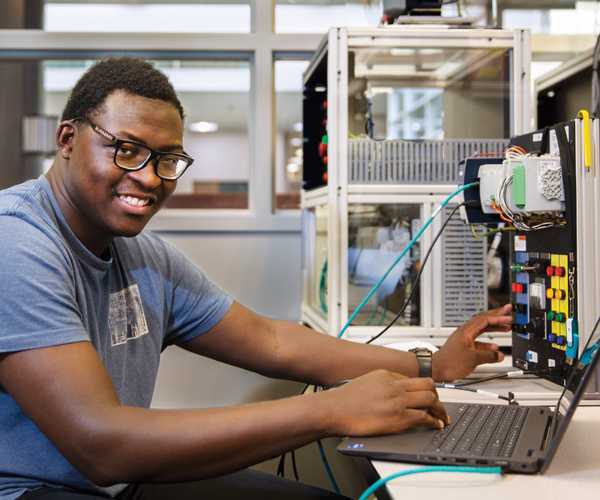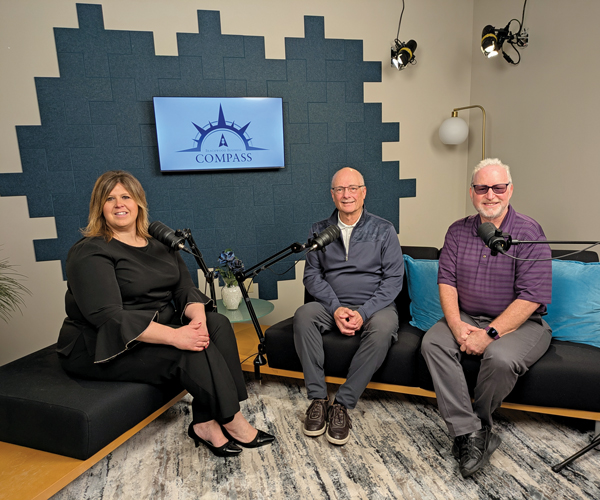Opportunity Corridor officially opened last November to a massive ribbon-cutting ceremony that included all of the fanfare of a transformational city-wide project.
There was a presentation of colors by the Cleveland Division of Fire Honor Guard, the Cleveland Division of Police Pipes and Drums band and a singing of the National Anthem by Pat Harris.
Representatives of the Ohio Department of Transportation (ODOT) welcomed guests and thanked all of those involved with the project, including District 12 Deputy Director John Picuri and ODOT Director Jack Marchbanks. Former Mayor Frank Jackson, County Executive Armond Budish and Grace Gallucci, executive director and CEO of the Northeast Ohio Areawide Coordinating Agency (NOACA) all spoke about the future and how the roadway would eventually transform the half-dozen neighborhoods surrounding the boulevard.
All of the stakeholders and participants of the roadway construction project deserved to take a bow. The strategic location of the corridor and its access to what are clearly disadvantaged neighborhoods gives it an upward potential not seen in Cleveland in years.
Now the real work starts. How can this corridor be turned into true
opportunity?
There are three major initiatives that need to be addressed: taking advantage of the corridor’s location in terms of the access it offers; dividing the corridor into different zones to afford maximum economic and job creation; and focusing on community reinvestment in the disadvantaged neighborhoods surrounding the area to promote workforce development and improve the quality of life for area residents. All three will require public/private partnerships of the major companies, nonprofits and government organizations of the community.
Location. Location. Location.
The Opportunity Corridor’s benefits are already being felt.
“The corridor creates access to developable and sizeable land parcels that are proximate to major hubs (downtown and University Circle) and to our transportation infrastructure,” says Baiju R. Shah, president and CEO of Greater Cleveland Partnership. “Given its location, there has been significant interest in developing land along and nearby the corridor, as demonstrated by the recent food business expansions.”
“The future is bright for this area of Cleveland because of its location to major interstates, University Circle, Downtown Cleveland and as a connector to our southern suburbs and Akron,” says Chris Ronayne, former president of University Circle Inc., who stepped down last year to run for Cuyahoga County executive. “But, I think the long-term vision is one of extraordinary community reinvestment. The roadway is really just the beginning.”
Commuter traffic is already heavy, but flows well. Head south down East 105th, and the massive Cleveland Clinic campus is to your immediate right. Turn left on any one of four major thoroughfares, and you’re in University Circle in minutes. Continue south past Quincy, and there are major “main street” intersections at arterials that include: Quincy, East 93rd, Woodland, Buckeye, East 79th, East 75th and Kinsman. Drive farther on, and you come to East 55th, with immediate access to Interstate 490 and Interstate 77 and access to southern suburbs, western neighborhoods, Interstate 71 and Cleveland Hopkins International Airport. The enhanced access to University Circle from the south and western suburbs, as well as neighborhoods like Tremont, Clark/Fulton and Brooklyn is already having a positive impact, especially on University Circle.
“The one thing that I have noticed in particular is that the Opportunity Corridor is making a giant difference to the thousands of people who come to work here every day,” says Gary Hanson, interim president of University Circle Inc. “We can’t just think of it as ease of access for visitors to University Circle or patients to our medical facilities, it is making a gigantic difference for the employers and employees in the circle.”
According to a spokesperson from Case Western Reserve University (CWRU), the “Opportunity Corridor speeds travel between I-490 and University Circle, which expands possibilities for people to work and visit in the nation’s No. 1 arts district. As economic development continues and accelerates along its path, our faculty and students can contribute to ongoing planning and community engagement, while our graduates may well contribute to the area’s growing workforce.”
Three Distinct Miles
Incredible access to key arteries is also key to future economic development along the 3-mile corridor, which is a boulevard of three distinct economic development personalities, each having its own mile.
It starts with health care and high tech to the north on East 105th.
“The Opportunity Corridor will drive significant economic and commercial growth in communities around our main campus,” says William Peacock, chief of operations for Cleveland Clinic. “Additionally, the roadway will be an important connection for the recently announced Cleveland Innovation District, a public-private partnership aimed at transforming Northeast Ohio into a $1 billion economic engine for biomedicine.
“Cleveland’s health care and education institutions have partnered with the state of Ohio and JobsOhio in this significant initiative, which supports research, education and bringing new jobs and corporations to the region.”
Unveiled by Ohio Gov. Mike DeWine and Lt. Gov. Jon Husted last year, the Cleveland Innovation District is a public/private partnership that includes the city of Cleveland, Ohio Development Services Agency and JobsOhio, along with Cleveland Clinic, University Hospitals, the MetroHealth System, CWRU and Cleveland State University. Its goal is to bring together the area’s world-class health care providers and educational institutions to create a pathogen center with global reach, improving the lives of millions of people and generating more than 20,000 Ohio jobs.
With its location in close proximity to the city’s four major health care providers, including MetroHealth across I-490 and Veteran’s Administration’s hospital on East 105th, the Opportunity Corridor is seen as a focal point for the Innovation District, a Medical Mile if you will.
“The section of the Opportunity Corridor along East 105th up to Cedar Avenue presents itself as an obvious Medical Mile,” says Ronayne. “It’s right in between the Clinic and UH. You have the Taussig Cancer Center right there and Explorys right around the corner.
“There are a large number of companies that want to be within easy reach of our health care leaders. But, you are also close to CWRU, with its innovation and research centers and lab space, and that has to present a great opportunity.”
Located at the convergence of I-490, and I-77, the mile to the very south and west of the Opportunity Corridor represents a great location for companies involved with logistics, be it rail or roadway, especially with its ease of access across town to Cleveland Hopkins International Airport.
“This bodes well for companies involved with transportation, freight or heavier manufacturing,” says Ronayne. “You have the convergence of four major highways right there, as well as access to the Central neighborhood.
“There is really a distinctive character to each mile of the Opportunity Corridor,” adds Ronayne. “I think the mid-section might play off of the existing land use in the area, where you already see companies like Orlando Baking and Miceli’s. This could be a home to other kinds of light manufacturing as well.”
This mid-section might also hold the most promise for residents of surrounding neighborhoods.
“If you look back at Cleveland’s history, there was a time when the people who worked in the steel mills actually walked to work from neighborhoods like Tremont,” says Ronayne. “We might be seeing the same thing all over again along the Opportunity Corridor. We could see a situation where neighborhoods and businesses develop and grow together. We could see the development of dynamic mixed-use communities and neighborhoods with job centers next to housing centers and social opportunities.”
Reinvestment in the Forgotten Triangle
Bringing us to what many consider both a key to the development of the 3,000-plus acres along the 3-mile corridor, as well as the future economic vitality of the entire city: reinvestment in the disadvantaged neighborhoods along the boulevard.
“There is a reason this area got the name the ‘Forgotten Triangle,’” says Ronayne. “Quite literally, there were decades of disinvestment. But, I think long term, the future is bright for this area. There is Fairfax, Buckeye-Woodhill, Broadway-Slavic Village and Central to the north. The roadway sets the table for development at key intersections, which will have a direct impact on the half-dozen neighborhoods along its path.”
Despite the change of mayoral administrations, development is already underway and moving forward, especially in the Fairfax neighborhood.
“At the corner of E. 105th Street or Opportunity Corridor and Cedar Avenue, the mixed-use Fairfax Meijer Market is underway,” says Denise Van Leer, executive director of Fairfax Renaissance Development Corp. “It includes an urban Meijer Grocery Store and 192 apartments above.
“The project is a partnership between the city of Cleveland, Cleveland Clinic, Fairfax Renaissance Development Corp. (FRDC) and Fairmount Properties, the developer.
“South of the market on Opportunity Corridor, FRDC and McCormack Baron Salazar will develop a mixed-income 82 unit apartment building scheduled to break ground in May 2022. Single-family new construction housing is underway in the area, as well with Knez Homes.”
The grocery store and other developments will create an opportunity for residents to walk to work, walk to a grocery store and have access to fresh foods at affordable prices. So much for the food desert.
“FRDC already has a workforce development program that connects residents to jobs not just in the Fairfax area, but also in the city of Cleveland,” Van Leer adds. “The economic investments will also generate intern opportunities for area youth, construction jobs, contracts for minority/female businesses and opportunities for training residents interested in technology/research for jobs that will be available in the Fairfax neighborhood.”
CWRU has helped lead a collective effort to secure a $35 million federal grant to revitalize the Buckeye-Woodhill neighborhood, and it is continuing to engage in the project as it progresses. Buckeye-Woodhill’s proximity to the corridor creates additional possibilities for neighborhood residents to secure jobs in the area — and to travel more easily to employers in other locations.
Earlier this year, a cold storage facility secured final funding to allow construction to begin at a site along the corridor; the building process itself creates jobs, and opportunities will only increase when it opens.
The project could create as many as 70 new jobs at Orlando Baking, which would use 50,000 square feet of the proposed 150,000-square-foot facility. The remainder would be rented to local grocers and others in the food industry. The cold storage infrastructure makes it easier for food service companies to relocate to the area.
The most ambitious project, and one that is a demonstration of the city’s dedication to the area, is Cleveland’s new police headquarters. The city has broken ground at a site on the corner of East 75th and Opportunity Corridor. It’s expected to be completed in 2026.
The new headquarters will have 180,000 square feet of office space. It will house police leadership and the Real Time Crime Center, where police officers monitor live video feeds from across the city. It will also house special units, including homicide. The ground floor will include a community plaza at the public entrance, as well as community meeting rooms and public records.
Opportunity 2.0
While the new Opportunity Corridor and the construction along its path will build the infrastructure to allow for revitalization and economic growth, there are fundamental changes that need to take place at the neighborhood and personal level. With the incoming mayoral administration, there has been something of a reset.
“This is actually a good thing,” says Chris Alvarado, executive director of Slavic Village Development. “The new administration is looking at doing more than just placing things like the new police headquarters in these neighborhoods.”
So is anyone reaching out?
“As a matter of fact, yes,” says Alvarado. We already have meetings scheduled with Jeff Epstein with the city of Cleveland. But, to be honest, it is going to take a lot of coordination between the city and the CDCs (community development corporations) to make this work. But, the city is being proactive by reaching out and asking about what we want to do.”
“I think it is really important for all stakeholders to work collaboratively on the strategy and priorities for the Opportunity Corridor if we are going to make it work,” says Jeff Epstein, chief of Integrated Development for the city of Cleveland. “We are getting substantial interest in development along the corridor, and it is the type of development that will benefit the surrounding community and create jobs. We need to make sure we are taking advantage of this.”
While buildings and infrastructure will support growth, true transformational change only happens when people change.
“That will come by making sure the folks who are living in our neighborhoods have the training they need for the jobs that will be available,” says Alvarado. “That means skills matching people with the jobs that are available.
“We will also need to provide the support that many folks will need to get through their first 90 days of employment. So, many things can happen in those first 90 days, like health issues, child care issues or issues around transportation. But, once you get past those first 90 days, you are pretty much set in employment.”
That means providing the kind of wraparound services that allow people to be prepared for employment.
“It’s not just enough to put up a corridor with buildings and employers. It’s not enough to have job fairs and people applying for jobs,” adds Alvarado. “We need to have long-term planning on a regional basis when it comes to getting these folks prepared for the new jobs.”
“We have done great work as a community to land and develop the Opportunity Corridor,” says Ronayne. “It has been a great partnership with the Ohio Department of Transportation and the state of Ohio to create not only a neighborhood connector, but also a regional connector, a job development and economic development opportunity. Long term, it will also require an extraordinary amount of community reinvestment.
“But, I think our best days are ahead.”




